|
| 50 years ago tomorrow, on March 23, 1969, my 25th birthday, I left the U.S. to begin an unforgettable year of Army duty in Vietnam and a subsequent odyssey that took me around the world, through Southeast Asia, across the USSR on the Trans-Siberian Railway and across Europe, before I returned to the U.S. in May of 1970. Below are some excerpts describing my arrival and first few days in Vietnam.
In March of 1969, I had been in the Army already a year, first completing the Engineer Officer Basic Course at Ft. Belvoir and then being assigned as a Basic Combat Training Officer at Ft. Polk LA, perennially ranked as the worst military post in the US (“The Army has some pretty terrible duty locations, but they were more unanimous than any other branch of the service on which post qualified as THE WORST. One soldier put it this way, “If God had to give the Earth an enema, he would attach the hose to Fort Polk.” Yeesh. Most blame the misery on the humidity, the bugs, or the fact that chain gangs are not at all uncommon in this swampy, far-from-everything town.” -- The US Military Towns You Definitely Don't Want to Be Stationed in, Ranked)
I hate to reveal it, but Vietnam was an upgrade from Ft. Polk.
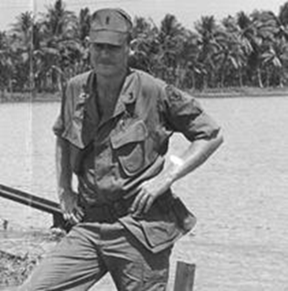
The following is from my journal and memoir, “Before and After Vietnam 1969-70 Military Experiences of Thomas K. (Tom) Butt.” Take a look at the full color video clips on pages 2 and 3.
I left on my 25th birthday from Ft. Lewis, Washington. I went out for dinner and drinks with Dick Johnson, the younger brother of an old friend I had originally met in Yellowstone. Dick was going to college in Seattle.
What was weird is that I didn’t know anyone on the plane. We were all individuals, going over to replace some other individual. It was a 707, with all the normal food, drinks, pretty young stewardesses and movies. It could have been a flight to anywhere, except it was all soldiers – all in uniform. We made one stop during the night in Tokyo. There was nothing to do but wander around the transient terminal of the airbase. My first postcard:
Tokyo, March 24, 1969
Dear Folks,
We didn’t get to leave Seattle until about 8:00 PM. It’s now about 1:00 AM on the 25th of March. I can’t exactly figure out how – but I completely missed my birthday. We’ve got an hour here in Tokyo, then 5 ½ hrs. more to Cam Ranh Bay – not much to do but gawk at cheap radios, TV’s, etc. Be in contact later.
Love, Tom
We landed at Cam Ranh Bay, and that rush of hot, humid air as we walked out the door and down the gangway clearly said “welcome to Vietnam.” We were bused to a compound of tropical buildings (“hootches” – as we later came to know them) near a beautiful beach. We were herded through a supply building, where we were given three uniforms (olive drab, jungle), two pairs of jungle boots, a baseball cap and a steel “pot” (helmet) and several pairs of olive drab socks, t-shirts and boxer shorts. Nametags and rank were issued and sewn on the uniform shirts. We were given a toothbrush and some kind of special toothpaste that was supposed to prevent cavities for one year. In the humidity, underwear gave me crotch rot, so I stopped wearing the boxer shorts altogether.
I was assigned a bed in a hootch, drank a few beers at the officer’s club, went swimming in the South China Sea and slept for a few hours before the plane left to our next destination at 4:00 AM.. I had no idea what was in store.
Long Binh, Vietnam, March 25, 1969
Dear Folks,
I’ve finally arrived to a permanent location, got a job, etc.
We landed at Cam Ranh Bay yesterday AM early – processed in-country in about two hours and had the rest of the day off while assignments were being made from Saigon. I kind of wish I’d never seen Cam Ranh – the vision will linger and spoil me. It’s a beautiful spot on a peninsula of land surrounded by huge mountains – a lot like Honolulu – and has one of the finest white sand beaches I’ve ever seen with Hawaii-type surf, etc. Everything was quiet and resort like, hot but with a refreshing sea breeze. Nobody carries weapons – it looks more like a war at Ft. Polk than Cam Ranh.
But then all good things end. I got an initial assignment to the 20th Eng. Brigade with hdqtrs [headquarters]. In Bien Hoa so we flew in there at 4:00 AM this morning. This part of the country is an entirely different story in appearance. The Bien Hoa-Long Binh complex sprawls for miles and miles in every direction – dust, red clay and thousands of slum looking temporary buildings, miles of barbed wire, bunkers, etc.
Anyway, the 20th Eng. Bde. [Engineer Brigade] Is made up of three groups, of which – the 159th – is my assignment – to be liaison officer between headquarters of the 159th and he 20th Bde. S-3. I’ve got very little idea of what the actual work entails except that it involves keeping track of 159th Group projects and writing progress reports, statistics, etc., for reports to the parent organization, the 20th Bde.
The 20th Brigade altogether seems to have all the support responsibility for IV and V Corps areas, or, the whole southern third of Vietnam. Our group, more specifically, has responsibility for a sector more or less surrounding Saigon and extending to the east, south and southeast. Ultimately, I will have to become familiar with each of the hundreds of projects in these areas. The lieutenant in the job now has 25 days left, so I’ve got that much time to get in the groove.
Even though the area here looks somewhat more garrison-like than Cam Ranh, it’s still very quiet and peaceful. Most of the people here scoff at the blow-up the press gives to incidents with the VC. I don’t reasonably see where they could be anyway; you can drive 30 miles in any direction and still be on this gigantic complex.
At any rate, I’ve got my gear, quarters and mama san. Tomorrow will start studying up on my job – let you know more about it as I find out.
Love, Tom
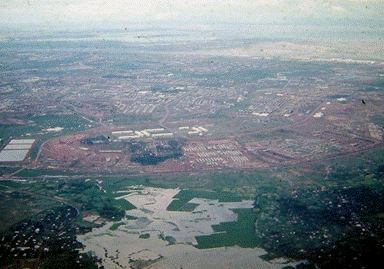
Long Binh Post
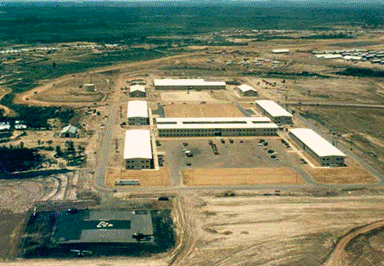
United States Army Vietnam (USARV) Headquarters at Long Binh. In the lower left corner is the helipad we routinely used
At Bien Hoa Airbase, someone from the 159th Engineer Group came to pick me up in a jeep. When we got to the 159th Engineer Group headquarters in Long Binh, maybe five miles away, I was ushered in to an interview with the Assistant S-3 officer, a Captain Terry Ryan. He asked me about my education and job experience and informed me that I was to be the replacement Liaison Officer (LNO) for the HHC (Headquarters and Headquarters Company), 159th Engineer Group, one of three groups making up the 20th Engineer Brigade.
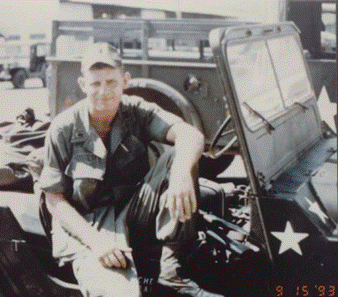
I was assigned a room in a “hootch,” which was, in this case, about 10 feet by 15 feet in a long building originally constructed with louvered walls and wire insect screen. It was a double row of such rooms, each with outside entrances, all assigned to officers. The roof was corrugated steel. Because the engineers were good at snagging stuff, it had a window air conditioner, and like the other rooms, the original louvers on mine had been covered with plywood. That air conditioner ran, without respite, until the day I checked out a year later, at which time it died.
The room had a single bed, a desk, a chair and a metal wardrobe cabinet. The bedspread was a camouflage pattern poncho liner.
At the company armory, I was issued an M-14 and a belt of magazines. Apparently, there was a shortage of M-16’s, and for some “garrison” soldiers, M-14’s were deemed appropriate to defend the post perimeter. The lieutenant I replaced gave me his .45 with pistol belt and two magazines.
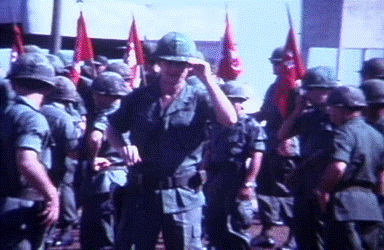
Tom Butt at a change of command ceremony at the 159th Engineer Group Headquarters
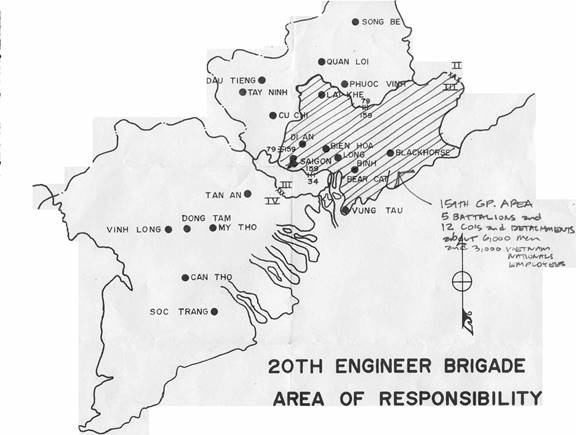
159th Engineer Group Area of Responsibility
Long Binh, March 26, 1969
Dear Folks,
A little of the mud is starting to clear about what’s going on around here. I went out today with the guy I’m going to replace to look at some of the job sites. Most of the group’s work is in this immediate area or on the main highway 60-150 miles north of here. Enclosed is a map showing the area covered by the 159th Engineer Group. A better definition of the job is becoming clear, but only on the essential matters: making reports to the chief of operations at brigade HQ and being an agent to obtain and pass on information between units on the job and the brigade HQ. Actually, I work directly for the Group operations officer and act as an inspector for him also – and might get to do a little design work, etc., as time allows. So as you can see, there seem to be elements of “do your own thing” along with the rest.
This Long Binh post is just like a primitive-type post in the states once you get inside the perimeter. In our group area are the standard office and quarters buildings, outdoor latrines and recreational buildings (movies, “O” club, tennis, basketball courts, etc., and a handball court in the design phase). I‘ve got a 10’ x 15’ room in the BOQ with a bed and a wall locker. As various people leave, I’ll be in line to inherit the finer things in life such as air conditioning, refrigerator, rugs, etc. It’s common practice of course to strip a room when its occupant leaves, so I’ll have to live in poverty for a month or so until I can play buzzard. There are about 25 officers in the headquarters and headquarters company. The engineers definitely have the highest standard of living in the army (can’t compare with air force, of course). What we can’t find in our own organization we have the most marketable services to barter with.
As I mentioned before, I got my first glimpse of the countryside today. This whole area, including Saigon, is considered secure enough to roam at will during the daytime, but a weapon is always carried along. It’s considered not exactly dangerous, but inadvisable to drive around outside the compound after dark, unless with a convoy or something. Most of the projects are within a few minutes’ drive from here. The others I can reach by catching a helicopter or plane from Bien Hoa. The villages around here are, of course, amazing but exactly what one would expect. I remember Martin’s term “dogpatch,” which pretty aptly describes the situation. Whatever “spring offensive” that happened around here seems to be over. For the first time in a month and a half, the base is back to the lowest class alert.
The weather is quite hot but pleasant, more so than Ft. Polk in the summertime, due to the constant breeze and cool evenings. The rainy season doesn’t start until May or June.
Every possible thing for day-to-day needs is available here and cheaper than at home, so the old “care package” is an anachronism as far as I am concerned. I do want you to send me some books, which I will list, and some magazine subscriptions. See that my subscription to Architectural Record and Progressive Architecture are renewed (check copies at home for information). Also send me the Northwest Arkansas Times and the following books from my shelves upstairs: 1. Structures Syllabus from East Bay AIA (big red lose leaf binder), 2. History of Architecture Syllabus from some AIA chapter in California and the three or four books on history of architecture. Also send all the structures manuals and textbooks that I have (including wood, concrete, steel, etc.).
Give me Martin and Jack’s addresses (I lost them somewhere). Everything is fine. I am looking forward to an interesting year.
Love, Tom
I arrived at Long Binh approximately one year after the 1968 “Tet Offensive,” and there were still some folks around who had been there at the time. They recounted how one self-important Engineer officer had gotten his finger shot off while “defending” our sector of the perimeter. Apparently, in an effort to commemorate the one-year anniversary of 1968 Tet, there were several forays by Viet Cong against the Long Binh Perimeter on February 22, 1969, about a month before I arrived. Below are flyers left by the marauders in the wire and picked up by the 159th Engineer Group G-2.
![From Wikipedia, February 19, 1969, assault on Long Binh from https://en.wikipedia.org/wiki/Tet_1969: Intelligence had indicators of the pending attacks. On 19 February, a defector surrendered to Army of the Republic of Vietnam (ARVN) forces and revealed a large VC force would attack key installations in the Saigon area to include Long Binh Post. Unfortunately, the reporting was delayed and did not reach Long Binh until the morning of 22 February 1969, the day the defector warned the attacks were set to begin. After sundown on the 22nd, elements of the VC 274th Regiment, 5th Division made their final preparations while occupying three hills along Highway 15 approximately three kilometers south of the base. That evening, several ambush squads from the 720th Military Police Battalion, 18th MP Brigade kept watch along potential avenues of approach to Long Binh Post. One of the MP ambush squads held a position within a kilometer of the VC stronghold. At 02:00 on 23 February, the 274th VC Regiment initiated their attack with an estimated 78 rounds of rocket and mortar fire from their positions. The rounds landed on post with some igniting the POL fuel site east of the highway.[1] The VC made several attempts to advance on the base, but were halted. Full-scale sweeping operations to secure the perimeter began just after noon that day. M113 armored personnel carriers and M551 Sheridan armored reconnaissance vehicles supported the forces on the ground while AH-1 Cobra gunships and OH-6 helicopters provided air support. These units made occasional contact, often with PAVN or VC who fought stubbornly from trenches and spider holes.[1]](19-3-22b_clip_image026.gif)
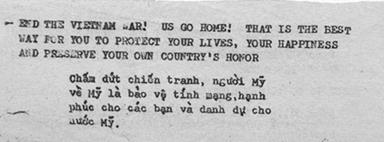
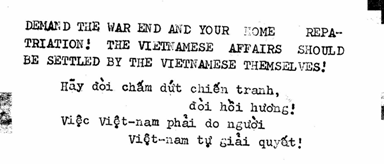
These propaganda flyers were distributed by the VC at Long Binh on February 22, 1969
The 159th HHC compound was located adjacent to Highway 316, the main highway to and from Saigon and about 17 miles north of Saigon. To get there, you entered the main Long Binh gate, turned right about a block. Between the compound and the highway, maybe 200 feet, was a wall of sand-filled 55-gallon drums and sandbags and lots of barbed wire. It may also have been mined. Further on, just down the hill and adjacent to the 159th compound was the 46th Engineer battalion compound. They had a really nice swimming pool.
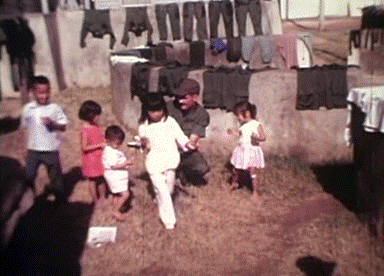
A party for kids of the mamasans (cleaning women) at the 159th Engineer Group Headquarters compound
My first days in-country were spent visiting dozens of 159th Engineer Group projects all over our Area of Operations. For the closer ones we drove in jeeps, and for those further away, we flew, mostly in Huey slicks
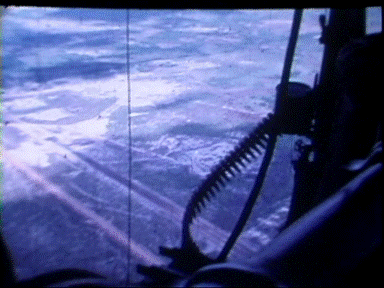
View from the door of a Huey slick
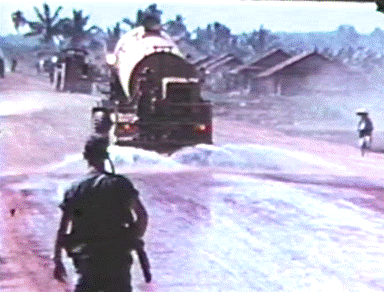
Roadbuilding was a prime mission of the 159th Engineer Group
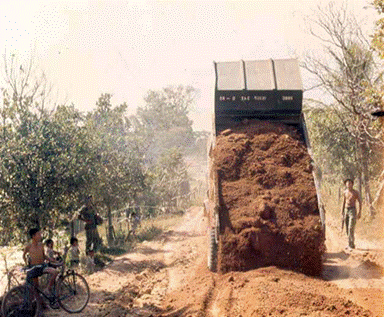
Roadbuilding – the red fill is the ubiquitous laterite
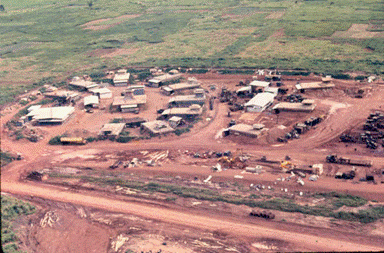
A firebase built by Army engineers
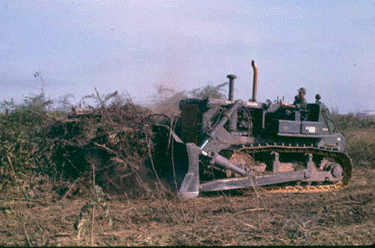
Land clearing using Rome plows was a constant mission of 159th Engineer Group troops
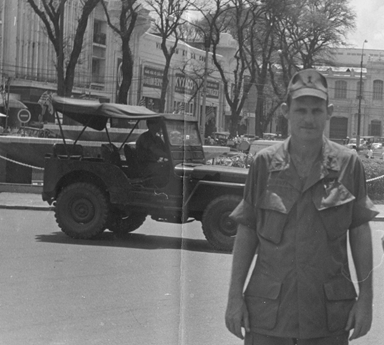
Saigon was on our Area of Operations too, so I had to check it out
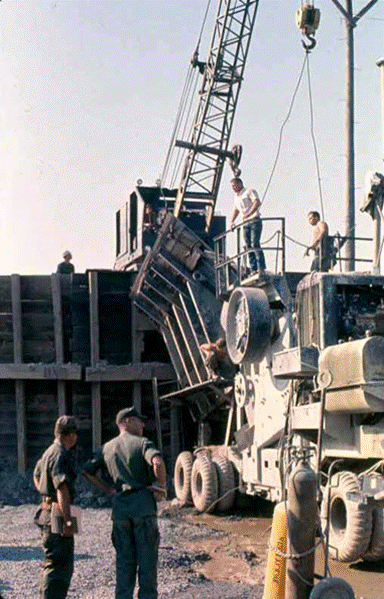
To build roads, you needed crushed rock and asphalt. The 159th Engineer Group operated three rock crushers and asphalt plants
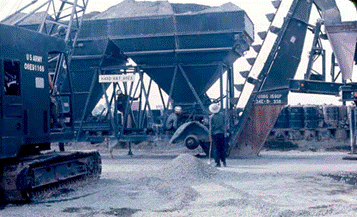
Rock crusher plant
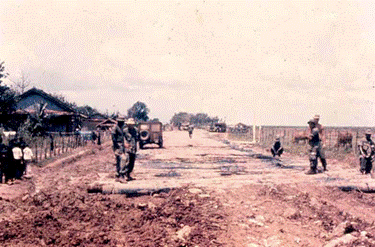
An unusual project was this “corduroy road,” perhaps the first one built by Army engineers since WWII. See https://www.youtube.com/watch?v=XLWCC2KrCCM.
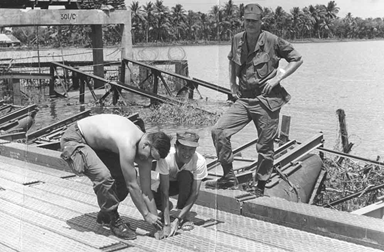
The Phu Cuong Bridge, blown by the VC in November 1969, repaired by the 159th Engineer Group in spring of 1969
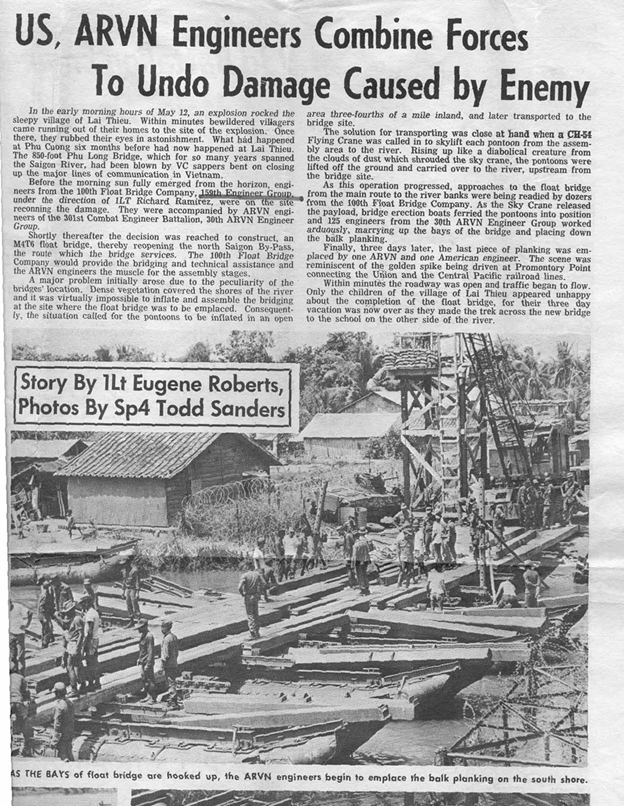
Building and maintaining bridges was another 159th Engineer Group priority. This float bridge was a collaboration of the 100th Engineer Company (Float Bridge), part of the 159th Engineer Group, and ARVN engineers.
|

